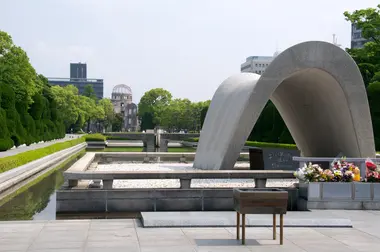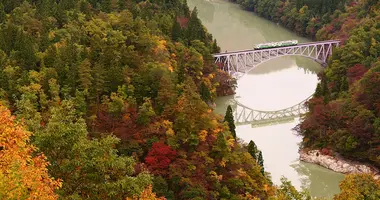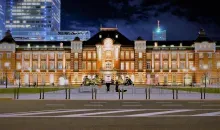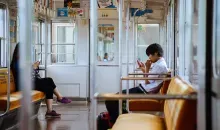How to get from Kyoto to Hiroshima
A key leg of the Japan Golden Route, going from Kyoto to Hiroshima entails traveling from one history-rich cultural hub to another. The Kansai region is connected directly to Hiroshima and the surrounding Chugoku region by way of the Tokaido-Sanyo Shinkansen that goes all the way down into Kyushu.
Getting from Kyoto to Hiroshima via Shinkansen bullet train
Hiroshima Station
To ride the Shinkansen bullet trains, individual tickets can be purchased with or without a reserved seat option, though we do advise making a reservation if possible during the peak travel seasons.These tickets start at 11,300 yen.
Additionally, holders of the Japan Rail Pass will be able to ride the Shinkansen out to Hiroshima from Kyoto; however, if it is specifically the Nozomi or Mizuho Shinkansen, an additional fee will be incurred.
The direct journey takes around 1 hour and 40 minutes to just under 2 hours, with 366 kilometers (227 miles) worth of distance in between. The first Shinkansen departs from Kyoto Station at 6:55 AM, and the last departure makes its way to Hiroshima from 10:14 PM.
Different types of Shinkansen bullet trains available on this itinerary:
| Hikari Shinkansen Bullet Train | Kodama Shinkansen Bullet Train | Nozomi Shinkansen Bullet Train | Mizuho Shinkansen Bullet Train |
*NOTE: All Shinkansen bullet trains on the Tokaido-Sanyo Line are accessible with the Japan Rail Pass; however, an additional fee is required to ride the Nozomi and Mizuho trains from Kyoto to Hiroshima.
Reserve Shinkansen tickets from Kyoto to Hiroshima!
Reserving seats on the Shinkansen
On Shinkansen bullet trains, individual ticket holders and holders of Japan Rail Passes can reserve seats in advance of boarding. Reservations are not always required for Shinkansen bullet trains because many of them have non-reserved cars with seats that are available on a first-come, first-served basis. These are often automobile numbers 1-4.
On certain trains, however, reservations are required for every car. However, we also strongly advise all visitors to try and book reservations for tickets during Japan's busiest travel seasons, which include the spring and the New Year's holiday. When purchasing a single ticket, a reserved seat is an additional cost; however, holders of a Japan Rail Pass are not charged this fee.
Oversized baggage on the Shinkansen
Passengers with large bags are required to meet a number of requirements in order to board the bullet train. Baggage over 160 cm in length, breadth, and height must be checked into the designated big baggage section located at the back of the train car, per Japan Railway regulations. It is also necessary for owners of such bags to reserve seats close to this section. Please be aware that bags larger than 250 cm in total are not allowed on the Shinkansen.
These baggage rules do not apply to baby carriages, musical instruments in cases, or sports equipment (bikes, snowboards, etc.) in cases.
Exploring Kyoto
Japan's historic capital, Kyoto, is a dynamic, historically rich city that is home to 17 different UNESCO World Heritage Sites. It is often the next stop on the Japan Golden Route itinerary for visitors from Tokyo. Situated in the culturally diverse Kansai region, which is well-known for its unique destinations, it is a popular travel destination.
Two of Kyoto's most well-known landmarks are the temple itself and the climb up to Kyomizudera, both of which make for rewarding outings. Go a little off the beaten path and explore the charming shops and restaurants lining the uphill alleys that lead up to the temple! The "gold and silver temples," Ginkakuji and Kinkakuji, are powerful reminders of the city's long history. With a combination of historic temples and even a beloved onsen, Kitaoji is a more restrained neighborhood with a calm atmosphere.
Even though Kyoto is a large city, it differs from other Japanese metropolises in that it is surrounded by mountains on three sides and has a large proportion of traditional architecture rather than high-rise buildings. Benefit from Kyoto's unique topography by enjoying a leisurely stroll and soaking in the views. The two-hour trek from Shogunzuka to Seiryuden, which leads to Chion-in Temple, is one of the easier walks in the area. Experience an unrestricted view of the city from an elevated viewpoint and learn about Kyoto in a way you never would have thought possible.
When departing from Kyoto to Hiroshima, travelers will depart from Kyoto Station, right in the heart of the ancient capital. Not many towns in the world can match Kyoto's distinction of being the first city to commemorate its 1200th anniversary—a feat that was reached in 1997 when the station underwent its current design by renowned architect Hiroshi Hara. There are a few restaurants, cafes, and convenience stores within, although the space is not as big as Tokyo Station. Nonetheless, the lit staircase—whose display varies with the season—is one of Kyoto Station's most identifiable features. Just a short stroll from the station is the much-loved Ume-yu, a sento bathhouse in a residential area with a unique vibe and quirky goods. It's a terrific place to unwind and pass time.
Exploring Hiroshima
The capital of the prefecture of the same name, Hiroshima, is a city that will always remain in history books. By fully embracing its recent and ancient heritage, Hiroshima has transformed into a symbol of progress, peace, and culture in the twenty-first century. For people who enjoy fine dining, waterfront views, and a rich history, Hiroshima has no shortage of things to do.
Hiroshima is the site of the first atomic bomb attack and the home of a number of well-known landmarks that have been constructed and maintained in memory of the victims of the tragedy. The "A-Bomb Dome," a domed structure that was the only one to survive the bomb radius, is one of the many memorials that can be found in Hiroshima Peace Memorial Park. The building has generally remained intact since then, with the exception of some damage to the upper portion that seems to have frozen in time.
Another big attraction for travelers is Hiroshima's distinctive culinary culture, which really originated in large part from the aftermath of the Second World War and the atomic bomb. The main way that Hiroshima-style Okonomiyaki varies from its equally famous Osaka counterpart is that it is layered and has soba noodles on the bottom. Okonomiyaki is a savory cooked-batter dish with a variety of mix-ins. Originally developed as a way to deal with the shortage of supplies after the war, this dish has grown into a specialty that is loved by both residents and visitors to Hiroshima. Two more well-known Hiroshima specialties are anago (sea eel), which is raised in the several oceans surrounding the city, and fresh, meaty oysters.
Off the coast of Hiroshima are some undiscovered gems that are well worth discovering. One of the most famous views in all of Hiroshima is that of Miyajima Shrine, which is well-known for its "floating" torii gate that rises out of the water during high tide and is especially beautiful at sunset. The main draw, however, is the shrine itself, which has been around for centuries and is recognized as a worldwide cultural landmark.
Okunoshima, an island a short distance away where around 1,000 wild rabbits graze freely, is sure to appeal to animal fans. There are several facilities on the island, such as a hotel and cafe, where visitors can spend the night.
When going from Tokyo Station to Hiroshima via bullet train, the Tokaido-Shinkansen is the required mode of transportation. Depending on the Shinkansen chosen, this route can be completed in four to five hours. You can be certain that the on-board wifi will keep you busy if your travel is longer than average. There will also be plenty of leg room and an option to purchase a premium "eki-ben," a bento box made especially for long-distance train travel, to snack on as you enjoy the scenery as it passes.
Witness the history of western Japan firsthand!
Both Kyoto and Hiroshima are two of Japan's most historically relevant cities, spanning from ancient times to the present day. The two cities are geographically, relatively, near, and are both connected via the Shinkansen train network, that is quick, easy, and convenient. Be sure to book your ticket from Kyoto to Hiroshima with or without a reserved seat or choose to get a Japan Rail Pass to make getting around the entirety of Japan as smooth and affordable as possible!













